文章目录
模拟实现list
示意图:
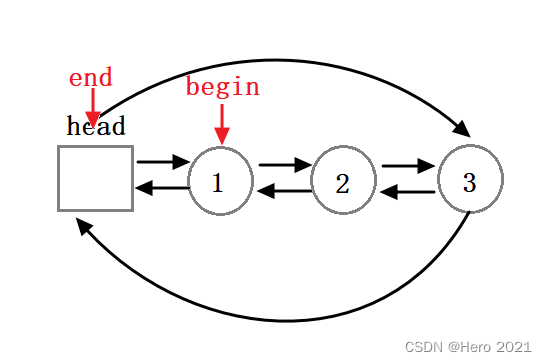
迭代器
正向迭代器类
我们之前所理解的是:迭代器理解为像指针一样的东西,但是在list中有些不同
// 迭代器逻辑
while(it!=l.end())
{
*it; // 解引用取数据
++it;// 自加到达下一个位置
}
我们可以来观察一下STL源码中大佬是怎么封装的:
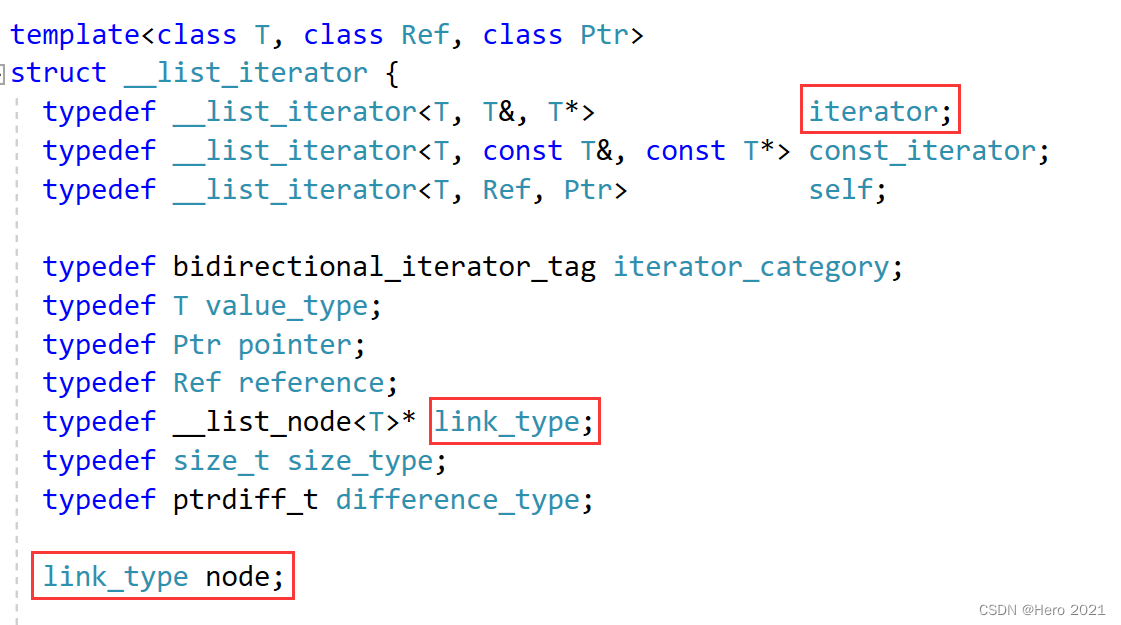
我们可以看到,只有一个成员,那就是一个结点的指针node,link_type又是一个自定义类型的指针,我们原生类型的指针在vector或者string中是可以直接typedef成为迭代器的,但是list底层是双链表,数据结构并非连续的,所以直接*it或者++it是不能够完成迭代器的任务的,但是C++中支持对于自定义类型的运算符重载,我们可以对解引用和自加两个运算符重载。
++it:就是当前指针存放下一个结点的地址
*it:解引用当前节点,取出值来
迭代器中,拷贝构造、运算符赋值重载、析构都不需要自己实现,使用默认生成的即可(即浅拷贝),因为迭代器是用自定义类型的指针封装的,访问修改链表,节点属于链表,不属于迭代器,所以不用管它。
我们在传入const版本的list时,list是const对象,需要的是const_iterator,这里会出现错误,不能将const的list的迭代器传给普通迭代器。如下所示例子:
void print_list(const list<int>& lt)
{
// lt.begin()是const迭代器(只可读)
// it是普通迭代器(可读可写)
list<int>::iterator it = lt.begin();
while (it != lt.end())
{
cout << *it << " ";
++it;
}
}
现在我们如何实现一个const的迭代器呢?
意思就是只可以读不能够写。可以++,- -,*解引用,但是解引用时不能修改数据。
可以想到这种写法:
const T& operator*()const
{
return _node->_data;
}
T& operator*()
{
return _node->_data;
}
但是并不是迭代器是const的,而是我们传入的list容器是const版本的。
我们可以将写一个const_iterator 的类版本,这样普通迭代器和const迭代器就不是一个类型了,是两个不同的类型了,这样会造成代码冗余。
template<class T>
struct __const_list_iterator
{
//...
// __list_iterator全部替换为__const_list_iterator
};
优化:
增加一个模板参数class Ref

这样第一个模板参数都是T,我们可以根据传入的第二个参数来推出时T&还是const T&,本来我们是要实现两个类的,现在只需要增加一个模板参数即可,这里体现出了C++泛型的优势!
迭代器我们说,它是像指针一样的东西,如果它是指向的一个结构体,需要用它的成员变量,我们还需要重载->箭头
struct Date {
int _year;
int _month;
int _day;
Date(int year = 0, int month = 0, int day = 0)
//这里要给默认参数,因为需要构建一个哨兵位头结点
:_year(year)
, _month(month)
, _day(day)
{}
};
void test_list2()
{
list<Date> lt;
lt.push_back(Date(2022, 1, 1));
lt.push_back(Date(2022, 1, 2));
lt.push_back(Date(2022, 1, 3));
lt.push_back(Date(2022, 1, 4));
// 现在来遍历日期类
list<Date>::iterator it = lt.begin();
while (it != lt.end())
{
cout << (*it)._year << "/" << (*it)._month << "/" << (*it)._day << endl;
++it;
}
cout << endl;
}
这里的*解引用然后再去.,我们可以重载->,让他可以去调用结构体的成员,这样更加快捷高效方便。
T* operator->()
{
return &(_node->_data);
}
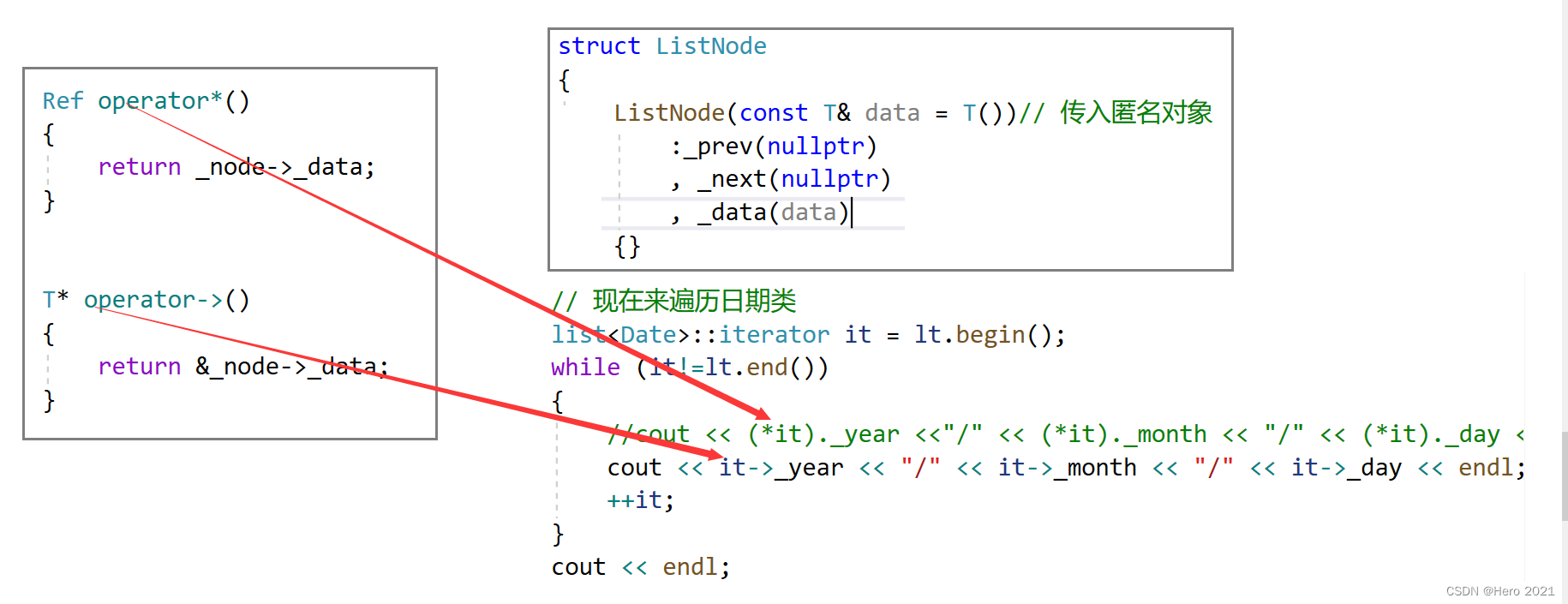
进一步解释:
*it调用operator*,返回一个结点对象,对象再.操作,拿到数据
it->调用operator->,返回对象的指针,(这里返回的是原生指针)再通过->调用用结构体成员,这里实际上应该是it->->_year,但是这样写,可读性很差,所以编译器做了一个优化,省略了一个->,所以所有的类型只要想要重载->,都会这样优化省略一个->
这里又会衍生出一个问题,那就是如果使用const_iterator,使用->也会修改数据,所以再增加一个模板参数

// 正向迭代器类
template<class T, class Ref, class Ptr>
struct __list_iterator
{
typedef ListNode<T> Node;
typedef __list_iterator<T, Ref, Ptr> self;// 再次typedef,方便后续的修改
Node* _node;
__list_iterator(Node* x)// 迭代器的实质,就是自定义类型的指针
:_node(x)
{}
// ++it 返回++之后的引用对象
self& operator++()
{
_node = _node->_next;
return *this;
}
// it++ 返回++之前的对象
self operator++(int)
{
self tmp(this);
_node = _node->_next;
return tmp;
}
// --it
self& operator--()
{
_node = _node->_prev;
return *this;
}
// it--
self operator--(int)
{
self tmp(this);
_node = _node->_prev;
return tmp;
}
// 返回引用,可读可写
Ref operator*()
{
return _node->_data;
}
// 返回对象的指针
Ptr operator->()
{
return &(_node->_data);
}
bool operator!=(const self& it)const
{
return _node != it._node;
}
bool operator==(const self& it)const
{
return _node == it._node;
}
};
反向迭代器类
实质:对于正向迭代器的一种封装
反向迭代器跟正想迭代器区别就是++,- -的方向是相反的
所以反向迭代器封装正向迭代器即可,重载控制++,- -的方向
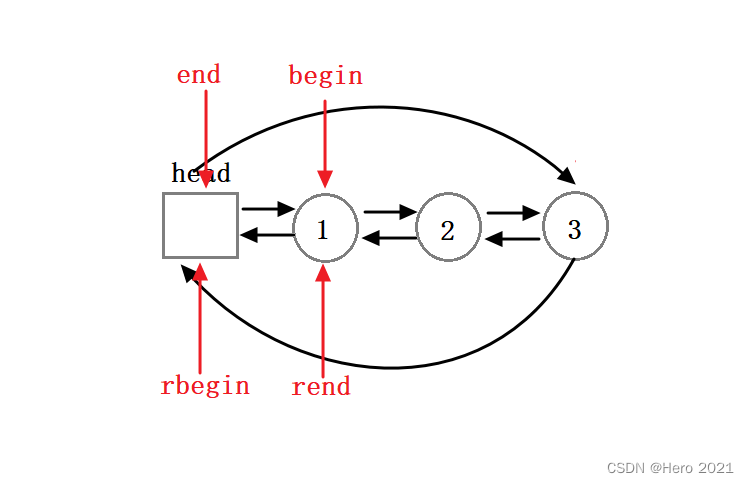
#pragma once
// reverse_iterator.h
namespace sjj
{
template <class Iterator, class Ref, class Ptr>
class reverse_iterator
{
typedef reverse_iterator<Iterator,Ref,Ptr> self;
public:
reverse_iterator(Iterator it)
:_it(it)
{}
// 比较巧妙,解引用取的是当前位置的前一个位置的数据
// operator*取前一个位置, 主要就是为了让反向迭代器开始和结束跟正向迭代器对称
Ref operator *()
{
Iterator tmp = _it;
return *--tmp;
}
Ptr operator->()
{
return &(operator*());
}
self& operator++()
{
--_it;
return *this;
}
self operator++(int)
{
self tmp = *this;
--_it;
return tmp;
}
self& operator--()
{
++_it;
return *this;
}
self operator--(int)
{
self tmp = *this;
++_it;
return tmp;
}
bool operator!=(const self& rit)
{
return _it != rit._it;
}
bool operator==(const self& rit)
{
return _it == rit._it;
}
private:
Iterator _it;
};
}
push_back尾插函数
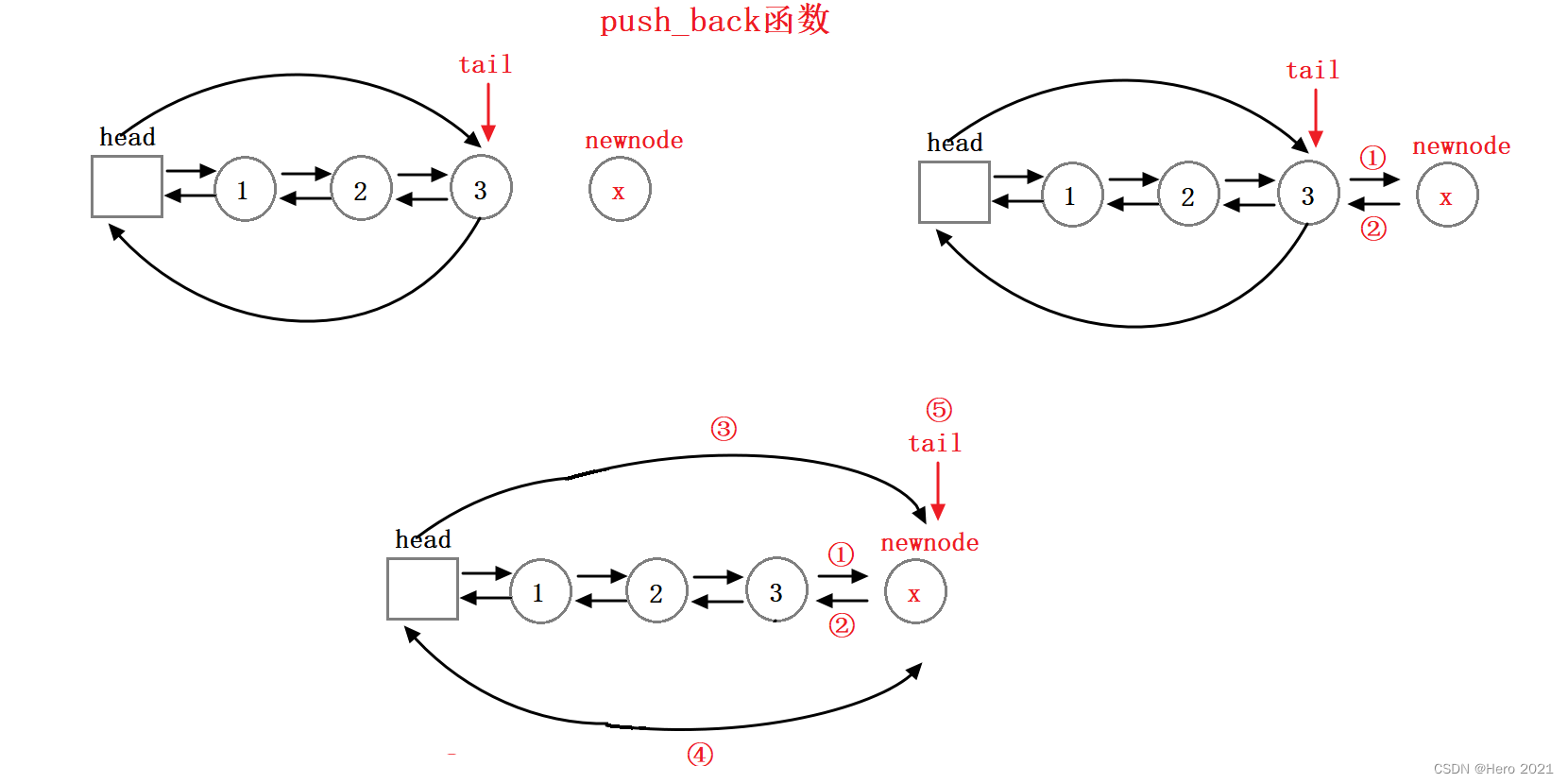
void push_back(const T& x)
{
// 先找尾记录
/*Node* tail = _head->_prev;
Node* newnode = new Node(x);
tail->_next = newnode;
newnode->_prev = tail;
_head->_prev = newnode;
newnode->_next = _head;
tail = tail->_next;*/
// 复用insert函数
insert(end(), x);
}
push_front头插函数
// 头插
void push_front(const T& x)
{
// 复用insert函数
insert(begin(), x);
}
insert插入函数
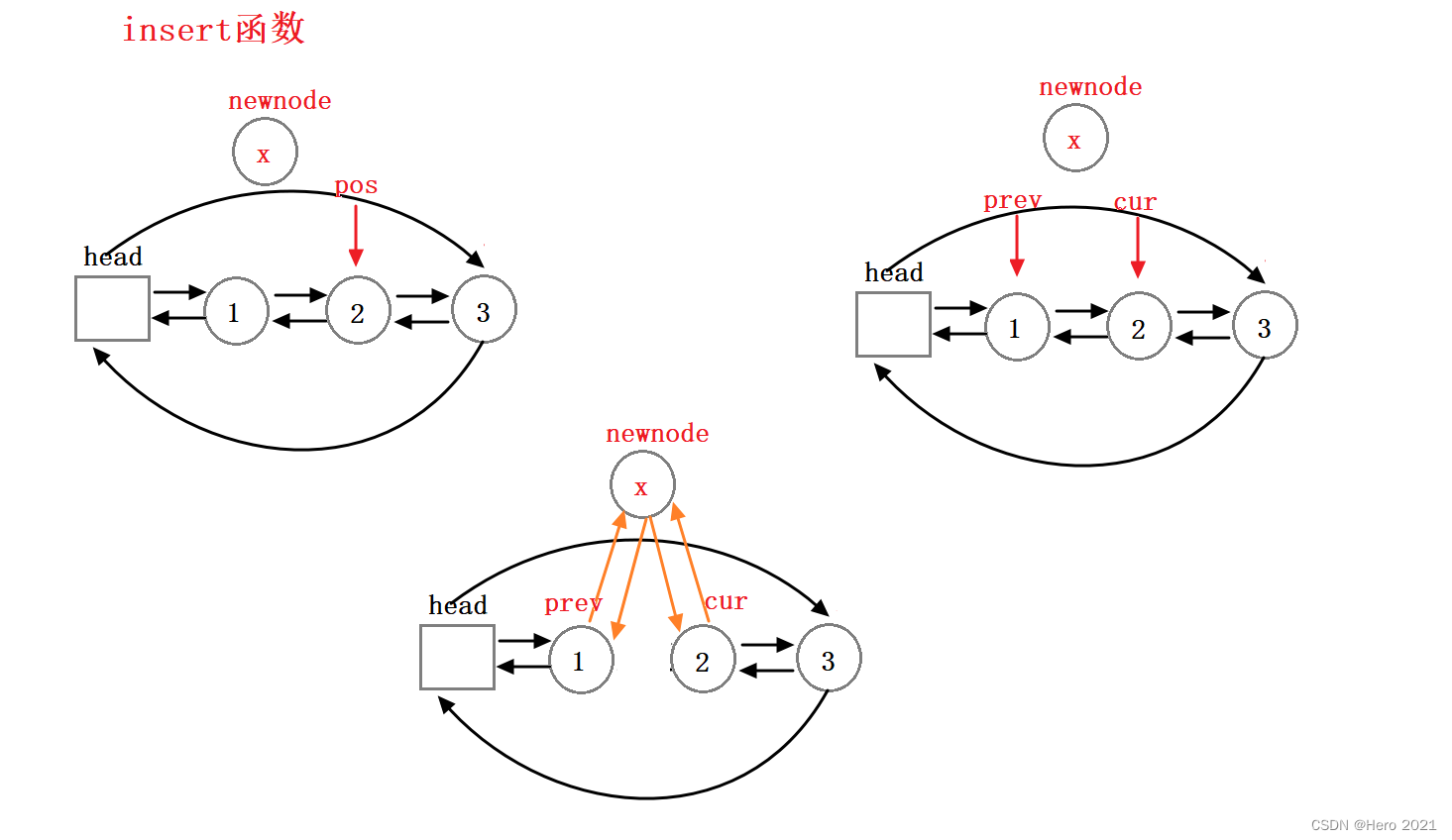
// 在pos位置前插入
iterator insert(iterator pos, const T& x)
{
Node* cur = pos._node;
Node* prev = cur->_prev;
Node* newnode = new Node(x);
prev->_next = newnode;
newnode->_prev = prev;
newnode->_next = cur;
cur->_prev = newnode;
return iterator(newnode);// 返回新插入结点位置的迭代器
}
注意:这里list的insert函数,pos位置的迭代器不会失效,因为pos指向的位置不会改变,vector中迭代器失效的原因是因为挪动数据,导致指向的位置的数据发生变化。
erase删除函数
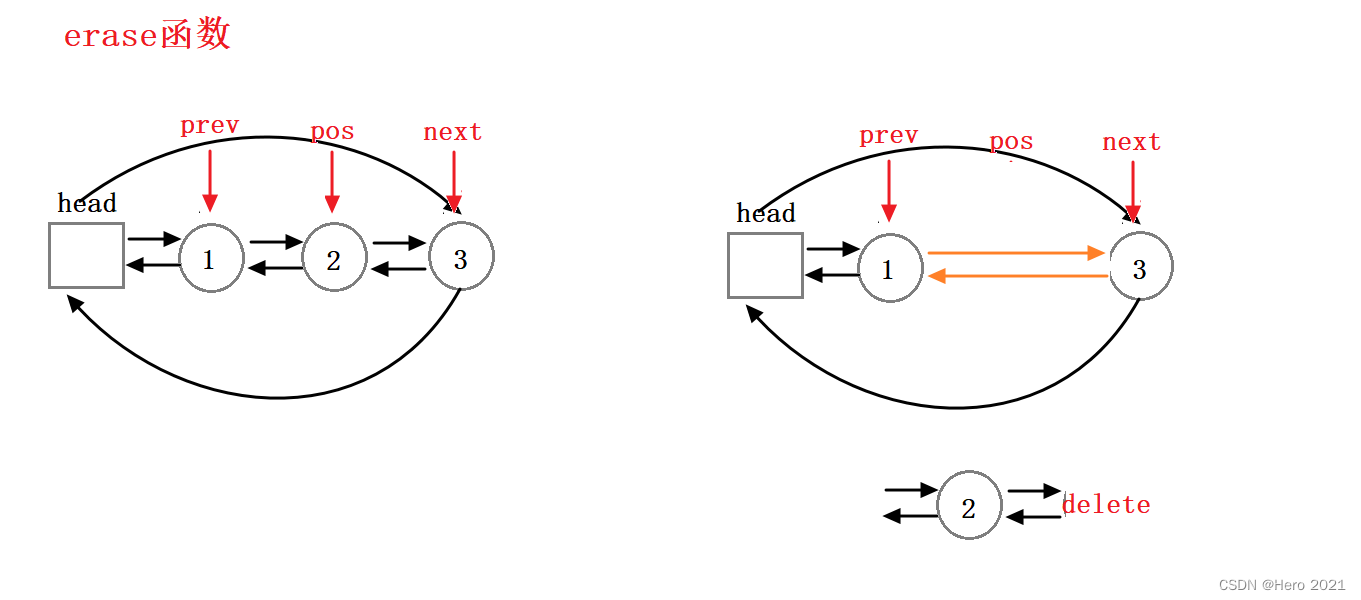
iterator erase(iterator pos)
{
assert(pos != end());//不能将哨兵位的头结点给删除了
Node* prev = pos._node->_prev;
Node* next = pos._node->_next;
delete pos._node;
prev->_next = next;
next->_prev = prev;
return iterator(next);// 返回pos位置的下一个位置的迭代器
}
注意:这里的pos位置的迭代器一定会失效,因为都已经将结点给删除了。
pop_front函数
// 复用erase函数
void pop_front()
{
erase(begin());
}
pop_back函数
// 复用erase函数
void pop_back()
{
erase(--end());
}
构造函数
list()
{
_head = new Node();
_head->_next = _head;
_head->_prev = _head;
}
// 函数模板,用迭代器区间进行初始化
template<class InputIterator>
list(InputIterator first, InputIterator last)
{
_head = new Node();
_head->_next = _head;
_head->_prev = _head;
while (first != last)
{
push_back(*first);
++first;
}
}
list(size_t n, const T& val = T())
{
_head = new Node();
_head->_next = _head;
_head->_prev = _head;
for (size_t i = 0; i < n; ++i)
{
push_back(val);
}
}
注意:

这两个构造函数一起使用可能会存在问题,填充版本和构造器版本可能会存在冲突,如下例子:
struct Date {
int _year;
int _month;
int _day;
Date(int year = 0, int month = 0, int day = 0)//这里要给默认参数,因为有一个哨兵位头结点需要初始化
:_year(year)
, _month(month)
, _day(day)
{}
};
void test_list4()
{
list<Date> lt1(5, Date(2022, 9, 9));
for (auto e : lt1)
{
cout << e._year << "/" << e._month << "/" << e._day << endl;
}
cout << endl;
list<int> lt2(5, 1);
for (auto e : lt2)
{
cout << e << " ";
}
cout << endl;
}
对于这两个:在实例化时会调用更加匹配的构造函数初始化
list lt1(5, Date(2022, 9, 9))它会正常调用list(size_t n, const T& val = T())
list lt2(5, 1)而它会将5和1推演成两个int,进而去匹配这个迭代器版本的构造函数
template < class InputIterator> list(InputIterator first, InputIterator last),但是与我们的本意,用n个val初始化原意相背,而其中有个*first,这里int去解引用必会报错
改进:再多提供第一个参数是int重载版本的list(int n, const T& val = T())构造函数
list(int n, const T& val = T())
{
_head = new Node();
_head->_next = _head;
_head->_prev = _head;
for (size_t i = 0; i < n; ++i)
{
push_back(val);
}
}
析构函数
~list()
{
clear();
// 析构与clear不同,要将哨兵位头结点给删除了
delete _head;
_head = nullptr;
}
list拷贝构造函数
浅拷贝会崩溃的原因是,同一块空间被析构了两次,所以我们要完成深拷贝
传统写法
// 传统写法
// lt2(lt1)
list(const list<T>& lt)
{
_head = new Node();
_head->_next = _head;
_head->_prev = _head;
for (auto e : lt)
{
push_back(e);
}
}
注意: 因为要调用push_back函数,push_back的前提是这个链表(lt2)已经被初始化了,所以必须要先搞一个哨兵位头结点,不然会崩溃
现代写法
// 函数模板
template<class InputIterator>
list(InputIterator first, InputIterator last)
{
_head = new Node();
_head->_next = _head;
_head->_prev = _head;
while (first != last)
{
push_back(*first);
++first;
}
}
// lt2(lt1)
list(const list<T>& lt)
{
_head = new Node();
_head->_next = _head;
_head->_prev = _head;
list<T> tmp(lt.begin(), lt.end());
std::swap(_head, tmp._head);
}
注意:lt2需要一个哨兵位头结点
list赋值重载函数
传统写法
// lt2=lt1
list<T>& operator=(const list<T>& lt)
{
if (this != lt)
{
clear(); // 将lt2清空
for (auto e : lt)// 再将值全部拷贝过去
{
push_back(e);
}
}
return *this;
}
现代写法
// 现代写法
list<T>& operator=(list<T> lt)
{
std::swap(_head, lt._head);
return *this;
}
其他函数
// 清空
void clear()
{
/*
iterator it = begin();
while (it!=end())
{
iterator del = it++;// 利用后置++,返回加加前的迭代器
delete del._node;
}
// 最后剩下哨兵位头结点
_head->_next = _head;
_head->_prev = _head;
*/
iterator it = begin();
while (it != end())
{
erase(it++); // 也可以复用erase,it++返回加加之前的值
}
}